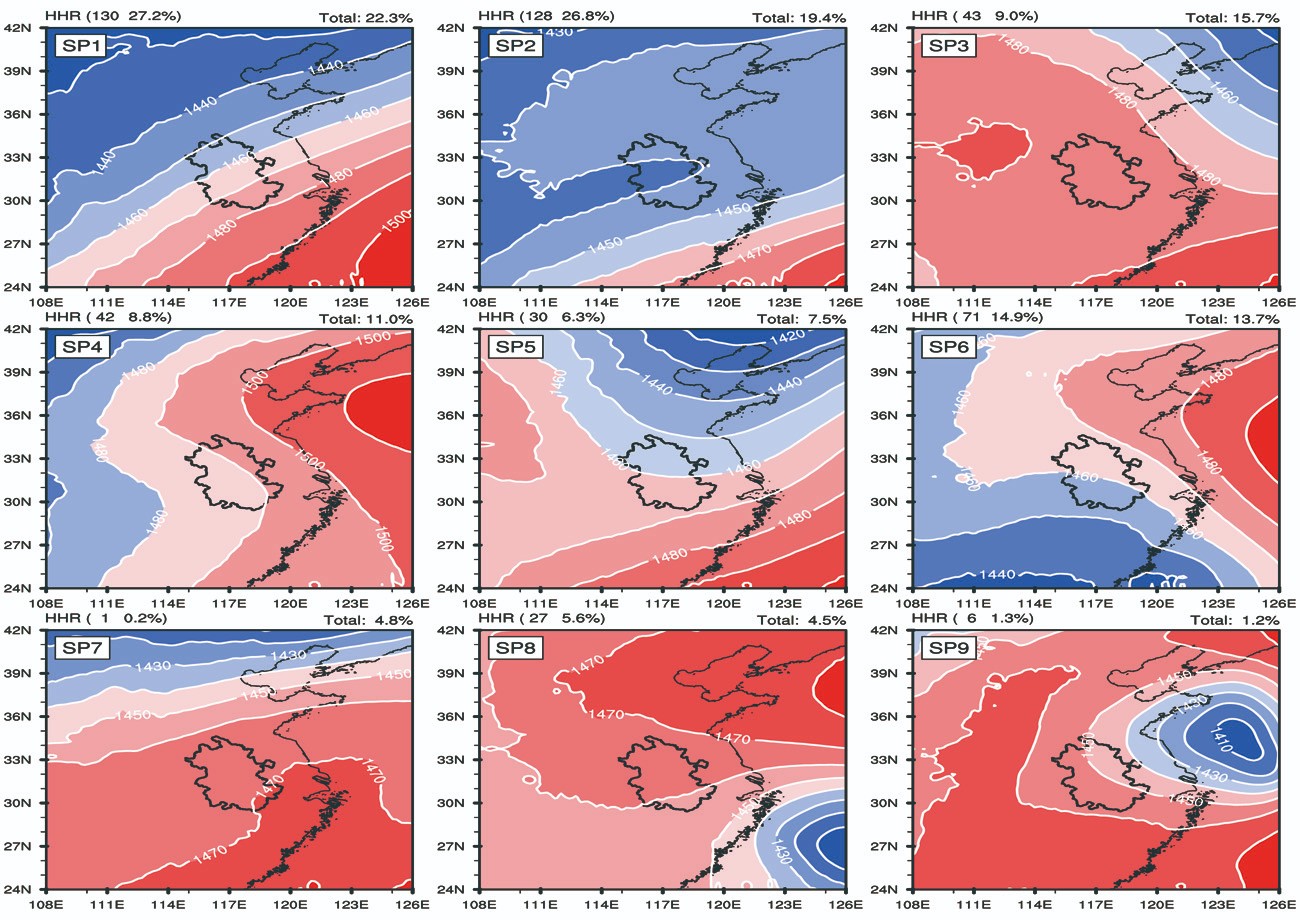本文已被:浏览 611次 下载 3394次
投稿时间:2021-05-08 修订日期:2022-04-08
投稿时间:2021-05-08 修订日期:2022-04-08
中文摘要: 采用2011—2018年5—8月逐10 min的地面稠密降水资料,统计分析了安徽省小时强降水(hourly heavy rainfall,HHR)事件在入梅前期、梅雨期、出梅后期的时空分布特征。结果表明,安徽省大别山至皖南山区西南部一带是HHR事件的易发区域,安徽省西南、东北地区HHR事件对暖季总降水贡献高达30%~40%。入梅前期,安徽省HHR事件日的发生频次低,雨强较弱;梅雨期持续时间长、累计雨量大;出梅后期雨强较大,持续时间短。按第99百分位阈值,60%以上极端持续时间(≥360 min)和极端累计雨量(≥138.0 mm)HHR事件出现在梅雨期,而60%以上极端10 min雨强(≥25.0 mm) HHR事件出现在出梅后期。梅雨期,HHR事件频次在凌晨06时和午后17时出现峰值;出梅后期,呈现明显的午后16时单峰结构。根据旋转T模式主成分客观分析法,将安徽省梅雨期HHR事件划分为低涡/切变型或锋面型(SP2型)和西北低槽型(SP1型);出梅后期则为南方低压或台风低压型(SP6型)和西北低槽型(SP1型)。其中,梅雨期SP2型HHR事件主要发生在大别山区、皖南山区及其过渡地带,是梅雨期HHR事件的主要贡献者;而SP1型HHR事件主要在大别山区、皖南山区及安徽东北部等山区较易发生。出梅后期,SP1型HHR事件呈现北多南少特点,而SP6型在大别山和皖南山区有较明显的HHR事件发生,是出梅后期HHR事件的主要贡献者。
中文关键词: 安徽,暖季,小时强降水事件,客观天气分型,统计特征
Abstract:Using the 10 min surface rainfall observations in Anhui Province during the 2011-2018 warm seasons (May to August), the spatio-temporal distributions of hourly heavy rainfall (HHR) events during the pre-Meiyu, Meiyu, and post-Meiyu periods are comparatively analyzed. The results show that the HHR events frequently occur over the areas from Dabie Mountains (Mt.DB) to the southwest of the southern Anhui Mountains (Mt.WN). The contribution of the HHR events over the southwest and northeast of Anhui Province to the total precipitation during the warm-season reaches 30%-40%. During the pre-Meiyu period, the HHR events have a lower occurrence frequency and weaker rainfall intensity than in the Meiyu and post-Meiyu periods. The HHR events during the Meiyu period last longer and produce a larger rainfall accumulation than those during the pre- and post-Meiyu periods, while those during the post-Meiyu period have larger intensity but shorter duration. Defined according to the 99th percentile threshold, more than 60% of the extreme persistent (accumulated rainfall) HHR events take place during the Meiyu period, while more than 60% of the extreme rainfall intensity HHR events with 10 min rainfall ≥25 mm occur during the post-Meiyu period. The HHR events’ occurrence frequency peaks at 06:00 BT and 17:00 BT during the Meiyu period, but exhibits a prominent single peak at 16:00 BT during the post-Meiyu period. Based on the rotating T model of the principal component analysis, the main synoptic circulation patterns of the HHR events can be classified as the southwest vortex/shear type or front type (SP2) and northwest trough type (SP1) during the Meiyu period. The SP2 type HHR events are the major contributor to the HHR accumulation and mainly occur in Mt. DB, Mt. WN and their transition zones. HHR events of the SP1 type tend to occur in mountainous areas such as Mt.DB, Mt.WN and northeastern Anhui. During the post-Meiyu period, the two major patterns are the southern low-pressure or typhoon type (SP6) and northwest low trough type (SP1). The major contributor to the HHR accumulation is the SP6 type HHR events that occur mainly in Mt. DB and Mt. WN, while the SP1 type HHR events take place more in the north than in the south.
文章编号: 中图分类号: 文献标志码:
基金项目:国家自然科学基金项目(41775050)、中国气象局预报员专项(CMAYBY2020-059)和江苏省气象学会青年科研基金(KQ202006)共同资助
| 作者 | 单位 |
| 吴照宪 | 安徽省池州市气象局,池州 247000 |
| 罗亚丽 | 中国气象科学研究院灾害天气国家重点实验室,北京 100081 |
| 刘希 | 中国气象局交通气象重点开放实验室,南京 210009 南京气象科技创新研究院,南京 210009 |
| 程东兵 | 安徽省池州市气象局,池州 247000 |
引用文本:
吴照宪,罗亚丽,刘希,程东兵,2022.2011—2018年安徽暖季短时强降水及其环流背景统计特征[J].气象,48(8):963-978.
WU Zhaoxian,LUO Yali,LIU Xi,CHENG Dongbing,2022.Statistical Characteristics of the Hourly Heavy Rainfall Events over Anhui Province During the 2011-2018 Warm Seasons and the Associated Synoptic Circulation Patterns[J].Meteor Mon,48(8):963-978.
吴照宪,罗亚丽,刘希,程东兵,2022.2011—2018年安徽暖季短时强降水及其环流背景统计特征[J].气象,48(8):963-978.
WU Zhaoxian,LUO Yali,LIU Xi,CHENG Dongbing,2022.Statistical Characteristics of the Hourly Heavy Rainfall Events over Anhui Province During the 2011-2018 Warm Seasons and the Associated Synoptic Circulation Patterns[J].Meteor Mon,48(8):963-978.


